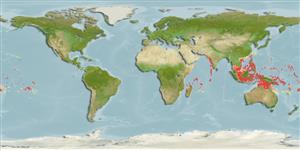Environment: milieu / climate zone / kisaran kedalaman / distribution range
Ekologi
laut dasar (demersal); kisaran kedalaman 1 - 82 m (Ref. 26267). Tropical
Western Pacific Ocean: Indonesia.
Size / Weight / umur
Kematangan: Lm ? range ? - ? cm
Max length : 7.1 cm TL jantan/; (Ref. 26267)
duri punggung lunak (Keseluruhan (total)) : 87; Sirip dubur lunak: 73; vertebrata, bertulang belakang: 48. This species is distinguished from all congeners by the combination of: ID pattern1-2-2-2-2; caudal-fin rays 12; vertebrae; 9 (3 + 6) abdominal, 48 total; hypurals 4; D 87, A 73; longitudinal scale rows 64; transverse scale rows 25; scale rows on the head posterior to the lower orbit 15; body elongate (BD = 24.9% of SL); preanal length long (PAL = 28.1% of SL); upper head lobe much smaller than lower lobe; head long (HL = 24.2% of SL), longer than head width (HW/HL = 0.97); postorbital length long (POL = 76.5% of HL); snout short (SNL = 10.4% of HL, SNL/ED = 1.25), slightly rounded anteriorly; dorsal-fin origin located at the vertical posterior to upper eye; predorsal length short (PDL = 18.1% of HL); eye is relatively small (ED = 8.4% of HL); eyes are unequal in position with anterior margin of upper eye greatly in advance of anterior margin of lower eye; fleshy ridge well developed on posterior part of ocular-side lower jaw; membrane covering upper and lower eyes; with continuous, fleshy membrane connecting anterior nostril with lower part of eye. Colouration: ocular-side pigmentation uniformly yellowish-brown; blind-side pigmentation uniformly yellow; both sides with obvious dermal spots on bases of anteriormost dorsal and anal fins (Ref. 126065).
Cross section: flattened.
Presumably frequents coastal lagoons with sandy bottom. More studies are needed concerning the ecology of this species.
Munroe, T.A. and B.N. Marsh, 1997. Taxonomic status of three nominal species of Indo-Pacific symphurine tonguefishes (Symphurus: Cynoglossidae: Pleuronectiformes). Ichthyol. Res. 44(2):189-200. (Ref. 26267)
Status IUCN Red List (Ref. 130435: Version 2025-1)
ancaman kepada manusia
Harmless
penggunaan manusia
Perikanan: tidak ada kepentingan
Alat, peralatan
laporan khas
muat turun XML
Sumber internet
Estimates based on models
Preferred temperature (Acuan
123201): 26.1 - 29, mean 28.2 °C (based on 1024 cells).
Phylogenetic diversity index (Acuan
82804): PD
50 = 0.5000 [Uniqueness, from 0.5 = low to 2.0 = high].
Bayesian length-weight: a=0.01000 (0.00244 - 0.04107), b=3.04 (2.81 - 3.27), in cm total length, based on all LWR estimates for this body shape (Ref.
93245).
Trophic level (Acuan
69278): 3.2 ±0.4 se; based on size and trophs of closest relatives
Daya lenting (Acuan
120179): Tinggi, Waktu penggandaan populasi minimum kurang dari 15 bulan (Preliminary K or Fecundity.).
Fishing Vulnerability (Ref.
59153): Low vulnerability (10 of 100).
🛈
